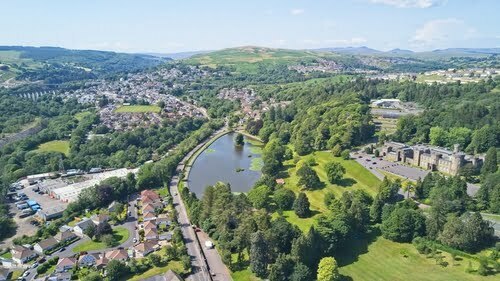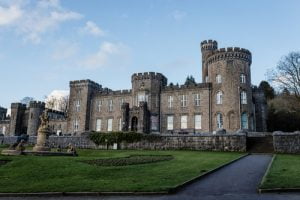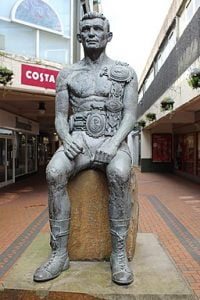
Merthyr Tydfil in Brief
Merthyr Tydfil is both an industrial town and a county borough in South Wales. The town is situated at the centre of the county borough, which extends northwards into the Brecon Beacons. Almost all of the borough lies within the historic county of Glamorgan. The town also stands on the banks of the River Taff, about 23 miles (37 km) north of Cardiff and 26 miles (42 km) northeast of Swansea. The town, commonly referred to as just ‘Merthyr’, takes its name from the Welsh princess ‘Tydfil’. She was martyred here by pagans around 480 AD, the town being named in her honour. The word ‘martyr’ translates to Welsh as ‘merthyr’. In 2020, the estimated population of the town of Merthyr Tydfil was 45,090.
A Fleeting History
In Millenia
The Celts were the first to occupy the Merthyr area, establishing several hill forts here from around 1000 BC onwards. In 74 AD, the Romans arrived and built a fort at Penydarren on the banks of the River Taff. The local Celtic tribes were initially hostile to the invaders but an accord of sorts was eventually established. However, around 120 AD, things changed greatly when the Romans decided to abandon the local fort with little notice.
The Normans
The next development of any significance in the area did happen for well over a millennium. In the late 13th century Gilbert de Clare, 3rd Earl of Gloucester, began building Morlais Castle on a wedge of high ground about 2 miles north of Merthyr. However, Humphrey de Bohun, 3rd Earl of Hereford, had already claimed the land. Their dispute culminated in the Battle of Maesvaynor (1291). King Edward I of England arrived in person at Merthyr to act as arbitrator.
In 1294, the castle was captured by the Welsh revolutionary Madog ap Llywelyn. He was arrested by Edward’s army, a year later, and imprisoned in London, where he remained until his death sometime after 1312. The castle was returned to Gilbert in 1295, but he died the same year. The castle’s remote and exposed location led to it being abandoned and its construction was never fully completed.
The 18th Century
The next development in the area was the establishment of a small iron foundry during Elizabethan times. However, the venture ultimately failed and the works had disappeared without a trace by the mid-17th century. Even as late as the mid-18th century, the only residents around Merthyr were a small farming community. However, following the earlier discovery of local coal and iron ore deposits, John Guest established an iron foundry here in 1759. The works went on to become the Dowlais Iron Company.
Around 1763, entrepreneur Anthony Bacon established another ironworks at Cyfarthfa. By the mid-1780s, there were four ironworks foundries in the Merthyr area. It was, in particular, the success of Merthyr’s iron industry that led to the construction of the Glamorganshire Canal. The Merthyr to Cardiff Bay canal opened in 1794, greatly improving the connectivity between the Taff Valley and the sea.
The 19th Century
By 1801, the population of Merthyr stood at around 7,700. In 1804, Richard Trevithick built the world’s first steam locomotive at Merthyr, adding to the town’s kudos. Ironmaster Josiah Guest took over the running of Dowlais Works from his father in 1808. In 1824, the owner of the Cyfarthfa Ironworks, William Crawshay II, built Cyfarthfa Castle. The ostentatious, castellated country mansion had 15 towers and 72 rooms.

Cyfarthfa Castle. Photo: Sameoldsmith/Shutterstock.com
By the 1820s, Merthyr was responsible for producing some 40% of Britain’s iron exports. By the 1830s, the town had the world’s largest ironworks and was internationally recognised as the centre of the global iron trade.
In 1841, Josiah Guest teamed up with, another local ironmaster, Anthony Hill to form the Taff Valley Railway Company. The opening of the railway saw it quickly supersede the Glamorganshire Canal as the main means of transport to Cardiff. Later, branch lines were built that connected the ”Valleys” with the Welsh ports and the rest of Britain. It was the development of the local rail network that greatly enabled Britain’s Industrial Revolution.
The iron produced at Merthyr could now reach Cardiff Bay in less than an hour. From there, it was exported throughout the British Empire and beyond. Merthyr grew in unison with its ever-expanding industrialisation and especially it’s iron industry. By 1851, the town population had reached 46,000, establishing it as by far the largest settlement in Wales.
Iron In Decline
In 1861, Merthyr’s population reached a new peak of almost 52,000. After that, iron production in the town went into a decline which saw several of its foundries closing. Merthyr’s inland location was now seen as a distinct disadvantage. Many workers emigrated to the USA and some even went to Ukraine. The latter followed ex-Merthyr ironmaster, John Hughes, to Donetsk, where he set up a plant. Meanwhile, Cyfarthfa’s ironworks owner John Crawshay failed to make the transaction into steel production. This led to the closure of the plant in 1874. His son, William, reopened it as a modern steelworks plant in 1879.
The 20th Century
In the early 20th century, several new mines opened around the Merthyr area and the town saw a brief resurgence. The growth of the town led to an award of county borough status in 1908. The local council bought Cyfarthfa Castle in the same year. Three years later, in 1911, the town population reached an ultimate peak of almost 81,000. However, in the same year, the Cyfarthfa plant, which had never achieved economical viability, closed. The works were briefly revived during WWI but saw a final closure in 1919. The area’s other steelworks and coal mines also began to decline after WWI.
By 1932, more than 80 per cent of men in the village of Dowlais were unemployed. During the 1920s and 1930s, some 27,000 people emigrated from the area. The Royal Commission even recommended that Merthyr’s county borough status be withdrawn. However, the town’s fortunes were temporarily restored during World War II, as steel production became vital for the war effort.
Post-war Merthyr’s iron and steel industries, along with coal mining, continued to decline. In 1948, the world-renowned American white goods manufacturer ‘Hoover’ set up a washing machine production plant in the town. Initially employing 350, numbers had risen to 5,000 by the mid-1970s.
The Modern Era
Economy
Since the end of WW2, Merthyr’s dependency on heavy industry for employment has gradually been replaced by light manufacturing and the service sector. In 2009, Hoover, while maintaining its head office, closed the Pentrebach plant with a loss of 339 jobs to the town.
Merthyr has over many years maintained consistently higher than national average unemployment figures. Long-term unemployment is, in particular, a problem in the town. On the plus side, tourism is the fastest-growing employment sector. Merthyr is blessed with an abundance of historical sites and cultural venues. The local area also has an ever-growing number of adventure activity venues.
Popular Events
Merthyr Rising is a music and arts festival that celebrates the town’s working-class culture and heritage. It usually takes place at the town’s Penderyn Square over the second weekend of June.
The Merthyr Street Chilli Fiesta usually takes place on the last Saturday in June. The free, outdoor event attracts some of the best producers of chilli products from across the UK. There’s plenty of street food and snacks to be had, but it’s obviously ‘chilli’ that’s the star.
Merthyr Food Festival is a celebration of both local and national food and drink that takes place in the town around mid-July. The annual food-lovers get-together usually attracts more than 40 stallholders and exhibitors, who range from professional chefs to local producers.
Twinning
Merthyr Tydfil has been twinned with Clichy, Hauts-de-Seine, France, since 1981

Merthyr Tydfil’s pedestrianised town centre. Photo: Ceri Breeze/Shutterstock.com
Getting to Merthyr
By Car
If you are driving to Merthyr from England, just head for the M4. Once on the M4, head for Cardiff. Once there, turn right and head northwards on the A470. The road takes you all the way to Merthyr. From Wales, the easiest way to Merthyr is to get onto the A470 as soon as possible.
By Coach
Megabus UK operates 3 buses a day from London Victoria Coach Station to Cardiff North Road.
By Train
There is a regular train service from London Paddington to Merthyr Tydfil, via Cardiff Central. The journey takes around 3 hrs 15 mins. From the North and Midlands, head to Cardiff Central.
By Air
The nearest airports to Merthyr Tydfil are Cardiff 38 miles (61 km), and Bristol 66 miles (106 km) away. There are regular train services to Merthyr from both locations.
A Historic ‘Red Flag’ Story
Did you know it was events at Merthyr Tydfil that spawned Wales’s association with the ‘Red Flag’?
In June 1831, an act of protest by Merthyr’s large mining community took place in what become known as ‘The Merthyr Rising’. It started when workers at Cyfarthfa Ironworks took to the town’s streets in protest against a cut in their wages. Calling for a general reform of worker’s rights, the protest quickly gathered momentum and soon spread to nearby towns and villages.
The protesters ended up seizing control of Merthyr for a full 8 days, forcing the elite to take shelter. The rebels flew the red flag for the first time on British soil as a symbol of workers’ defiance. The authorities sent hundreds of soldiers to restore order but not before 24 people were reportedly killed. Afterwards, the budding trade union movement, along with its symbolic red flag, took a firm foothold in the South Wales area.
A Notable Son – Howard Winstone
Howard Winstone was born in Merthyr Tydfil on 15 April 1939 and went on to live his whole life in the town. The then promising featherweight boxer turned professional in 1959. He became British champion in 1962, and European champion, a year later. After several unsuccessful attempts, he finally gained a world title in January 1968. He retired from boxing 6 months later, after losing in the first defence of his title. In all, he won 61 of his 67 professional fights.
In 1969, Winstone was awarded an MBE for his achievements in boxing. Soon afterwards, he was made a Freeman of Merthyr Tydfil. He died on 30 September 2000, aged 61, following a diagnosis of kidney disease. A year after his death, a bronze statue of the famous boxer was erected in the town’s St. Tydfil’s Square. In 2005, he was voted Merthyr Tydfil’s greatest citizen of all time, by local residents.

The statue of Howard Winstone. Photo: Wikipedia Commons
Sport in Merthyr
Merthyr Town FC
Merthyr Town FC is a semi-professional football club currently (2021/22) playing in the Southern League Premier Division South. That’s the 7th tier of the English football league system. Nicknamed ‘The Martyrs’, ‘The Romans’, or the ‘Red & Greens’, the club plays home games at Penydarren Park.
Merthyr RFC
Merthyr RFC is a Welsh rugby union club that plays in the Welsh Premier Division. Known as the ‘Ironmen’, they play home games at the 4,500 capacity ‘The Wern’.
Mountain Biking
Set in more than 2,000 acres of woodland, ‘Bikepark Wales’ was the UK’s first purpose-built mountain biking centre. It’s located at Gethin Woods, just south of Merthyr Tydfil.
Places to visit in Merthyr
Cyfarthfa Castle Museum and Art Gallery
Cyfarthfa Castle houses a museum and art gallery. It’s situated on the northern outskirts of Merthyr, a stone’s throw from the Brecon Beacons National Park. The castellated mansion is set on 160 acres of parkland, that contains a lake, formal gardens, a miniature railway, and a children’s play area. It has a variety of art displays, plus collections of Greek, Roman, and Egyptian artefacts. It’s a cheap day out as adult entry is only £2 and kids go free. There’s also a very decent tea room.
Morlais Castle
Built on the site of a previous Iron Age hillfort, Morlais Castle dates from the late 13th century. There is not too much evidence of the castle that once stood here but the limestone escarpment on which it was built still dominates the local landscape. The views over the Taf Fechan Gorge from the local vantage point make it well worth a visit.
Garwnant Visitor Centre
The Garwnant Visitor Centre is a wooded area of the Brecon Beacons that has an array of outdoor activities to do. These include walking trails, mountain biking routes, children’s play areas and a visitor centre.
Vertigo Trampoline Park
The park offers one of the most popular activities in Merthyr. With over 40,000 sq ft of bounciness on offer, it’s the largest trampoline park in Wales. There are also adult fitness classes, both adult & kiddies ninja courses and a range of other fun activities. Charges are around £5 per hour on weekdays and £8 per hour at weekends.
Brecon Beacons National Park
For some great hiking, you can venture out into the nearby Brecon Beacons National Park. The park is home to South Wales’s highest peak Pen y Fan, which is 2,909 ft (886 m) high. It’s a somewhat challenging 12-mile trek from Merthyr to the peak, which takes around 5 hours. More popular is the 9-mile round trip Brecon Horseshoe Walk from the car park at Lower Neuadd which takes a similar time.
Joseph Parry’s Cottage
Dr Joseph Parry, one of Wales’s best-known musicians and composers, was born at No. 4 Chapel Row, Merthyr Tydfil in 1841. He moved to the USA, aged 13, but went on to achieve worldwide fame through his composition of hymns and operas. The cottage has been beautifully preserved as a typical ironworker’s family home of the period. Visits are by appointment only.
Other places you might want to visit, include:
- BikePark Wales – It’s the UK’s top mountain biking destination.
- Adventure Land – A ‘must’ for families with young children.
- Brecon Mountain Railway – Your big chance to ride on a steam train.
- Rock UK Summit Centre – For those of all ages who are looking to get to the top.
- The Taf Trail – 8 miles of cycling/hiking trail that passes right through Merthyr.
- Taf Fechan Nature Reserve – 3 miles from town, a must for all nature lovers.
- Sk8topia Skatepark – located at Merthyr’s Leisure Centre, it’s the largest in Wales.
Moving to Merthyr?
Properties sold in Merthyr Tydfil had an overall average price of around £147,00 over the last year (to May 2022). The majority of houses sold during that period were terraced properties, which fetched an average price of £108,500. Flats, in the town, sold for an average of £68,500, semi-detached houses for £149,000, and detached properties for £285,000. The overall, sold prices in Merthyr Tydfil over the last year were 7% up on the previous year.
Thinking of a Staycation?
Are you thinking of holidaying in the UK? If so, why not check out some of our other travel guides for some staycation ideas. I think you might be surprised at the variety of great things to do in the UK.
Header image: Emma Griffiths/Shutterstock.com
Why not take the Merthyr Tydfil quiz?
Quiz Maker – powered by Riddle


